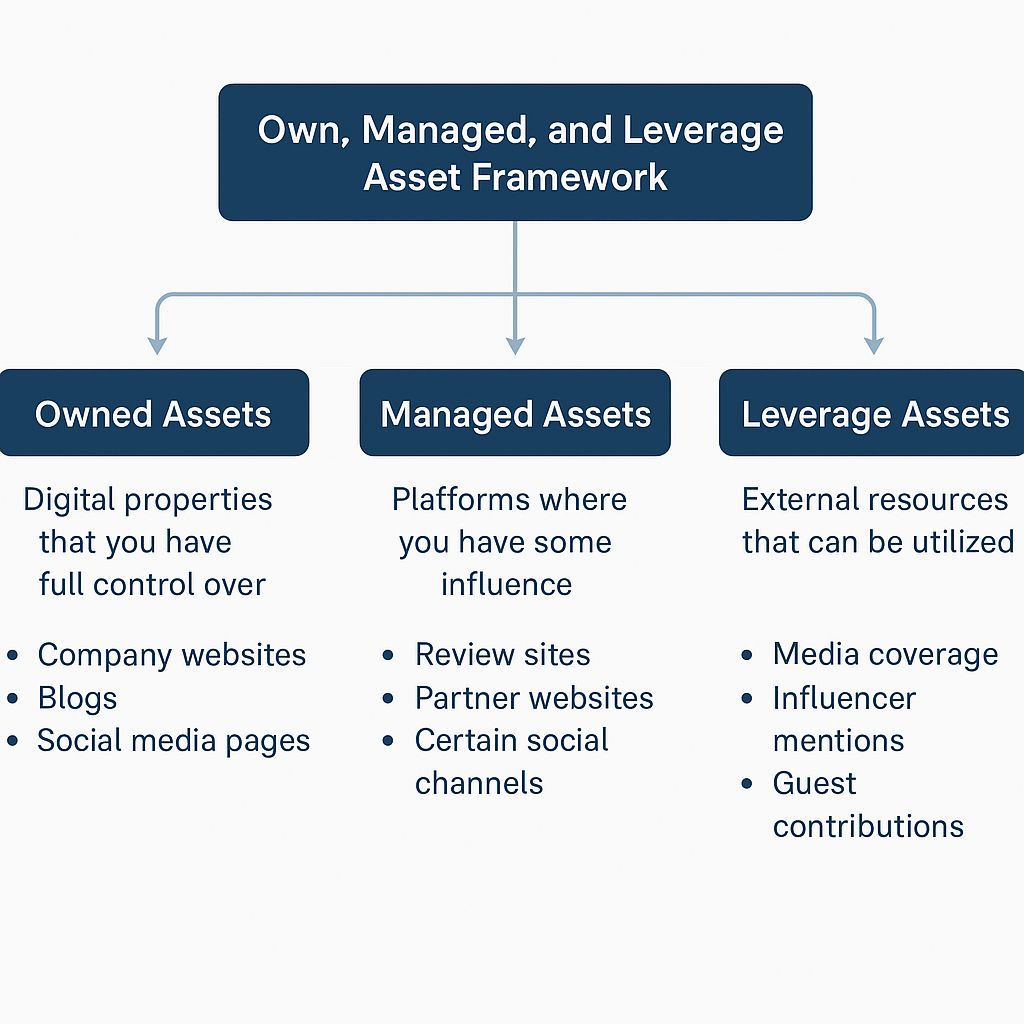Maximizing Digital Visibility with the Own, Managed, and Leverage Asset Framework

Summary:
In an increasingly competitive digital environment, maintaining strong visibility in search engine results is essential. With constant algorithm updates and shifting online behaviors, businesses need a structured strategy to manage their digital presence. The Own, Managed, and Leverage Asset Framework (OML) offers a comprehensive approach to categorizing and optimizing digital assets, helping brands gain greater control, influence, and reach across the web.
Key Takeaways:
Search visibility is critical for both brand awareness and business growth.
Frequent Google algorithm changes make it difficult to control how content ranks.
The OML framework helps organize digital assets into three actionable categories:
Owned (websites, blogs, branded content)
Managed (business directories, social profiles)
Leverage (media mentions, influencer content)
Aligning this framework with SEO strategies improves search rankings, online reputation, and content authority.
In today’s fast-paced digital landscape, maintaining visibility on search engine results pages (SERPs) is critical for both businesses and individuals. Frequent algorithm updates from Google make it increasingly difficult to control how your information appears online. However, with a strategic approach like the Own, Managed, and Leverage (OML) Asset Framework, organizations can optimize their digital presence and improve search rankings effectively.
What Is the Own, Managed, and Leverage Framework?
The OML framework organizes digital assets into three strategic categories:
Owned Assets – Platforms under your full control, such as your company website, blogs, and official social media profiles.
Managed Assets – Channels where you have partial control, including business directories, review platforms, and social media networks you engage on but don’t own.
Leverage Assets – External platforms that mention or feature you, like media coverage, guest posts, and influencer endorsements.
By focusing on all three, businesses can build a well-rounded digital strategy that balances control with reach.
Building a Strong Foundation with Owned Assets
Owned assets form the foundation of your online presence. Since you control them entirely, they’re ideal for shaping your brand narrative and executing SEO strategies.
Tactics to optimize owned assets include:
Content Optimization: Refresh blog posts, landing pages, and website copy using relevant keywords and valuable insights.
Technical SEO: Prioritize fast load times, mobile responsiveness, and accurate metadata.
Internal Linking: Create intuitive link structures that enhance user experience and improve crawlability.
An optimized owned presence ensures your most important messages reach the right audience consistently.
Enhancing Visibility Through Managed Assets
Though you don't fully control them, managed assets still impact how your brand appears online. They include:
Review Platforms: Sites like Google Reviews, Yelp, and Trustpilot where you can respond to feedback and shape perception.
Business Directories: Profiles on Google Business, LinkedIn, or industry-specific platforms.
Social Media Accounts: Even if algorithmically controlled, your active participation allows brand storytelling and engagement.
Best practices include:
Regularly updating your information across platforms.
Responding professionally to reviews—positive or negative.
Engaging consistently to maintain visibility and relevance.
Expanding Reach with Leverage Assets
Leverage assets extend your reach beyond your immediate ecosystem. These are not directly controlled but can significantly boost authority and awareness.
Key examples:
Media Mentions: Coverage in news outlets or trade publications.
Guest Contributions: Articles or blog posts on respected external sites.
Influencer Collaborations: Mentions or endorsements from trusted voices in your industry.
To benefit from leverage assets, focus on relationship-building, outreach, and creating content worth amplifying.
Integrating SEO Across All Asset Types
Search engine optimization enhances the performance of each asset category. Consider the following:
Keyword Strategy: Identify and integrate target keywords across owned content and metadata.
Backlink Building: Encourage authoritative backlinks from leverage assets to boost owned domain authority.
Local SEO: Optimize managed listings like Google Business Profile for local discovery.
A unified SEO strategy ensures each asset supports and strengthens the others.
Measuring Success and Improving Continuously
Optimization isn’t a one-time task—it requires ongoing evaluation. Use tools like Google Analytics and Search Console to monitor:
Organic Traffic: Track search-driven visitors to your owned properties.
Keyword Rankings: Measure performance across your key search terms.
User Engagement: Monitor bounce rates, time on site, and page interactions.
Conversion Metrics: Understand how digital assets contribute to leads, downloads, or sales.
These metrics provide valuable feedback to refine your strategy over time.
Leveraging the Framework for Brand Success
The Own, Managed, and Leverage Asset Framework not only enhances search visibility but also serves as a foundational tool for overall brand management and marketing. By segmenting digital assets based on levels of control and influence, both individuals and businesses can execute more cohesive campaigns, maintain consistent messaging across channels, and strategically build authority in their niche. This structured approach enables marketers to identify opportunities for growth, manage reputation proactively, and drive performance with precision—making it a valuable asset in today’s competitive digital environment.
Conclusion
In a competitive digital environment, the Own, Managed, and Leverage Asset Framework offers a powerful model for sustained visibility and authority. By focusing on what you control, managing what you influence, and leveraging what you can earn, you create a dynamic and resilient online presence. Combined with a strong SEO foundation and performance tracking, this approach positions your brand for long-term digital success.